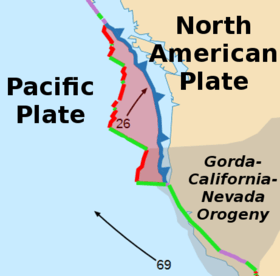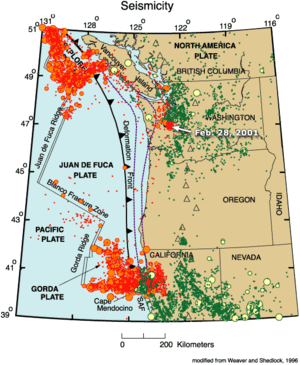Juan de Fuca Plate
| Juan de Fuca Plate | |
|---|---|
 | |
| Type | Minor |
| Approx. Area | 250,000 km2 (96,000 sq mi)[1] |
| Movement1 | north-east |
| Speed1 | 26mm/year (1.0 in/yr) |
| Features | Pacific Ocean |
| 1Relative to the African Plate | |

The Juan de Fuca Plate is a tectonic plate generated from the Juan de Fuca Ridge and is subducting under the northerly portion of the western side of the North American Plate at the Cascadia subduction zone. It is named after the explorer of the same name. One of the smallest of Earth's tectonic plates, the Juan de Fuca Plate is a remnant part of the once-vast Farallon Plate, which is now largely subducted underneath the North American Plate.
Origins
The Juan de Fuca plate system has its origins with Panthalassa's oceanic basin and crust. This oceanic crust has primarily been subducted under the North American plate, and the Eurasian Plate. Panthalassa's oceanic plate remnants are understood to be the Juan de Fuca, Gorda, Cocos and the Nazca plates, all four of which were part of the Farallon Plate.
Extent

The Juan de Fuca plate is bounded on the south by the Blanco Fracture Zone (running northwest off the coast of Oregon), on the north by the Nootka Fault (running southwest off Nootka Island, near Vancouver Island, British Columbia) and along the west by the Pacific Plate (which covers most of the Pacific Ocean and is the largest of Earth's tectonic plates). The Juan de Fuca plate itself has since fractured into three pieces, and the name is applied to the entire plate in some references, but in others only to the central portion. The three fragments are differentiated as such : the piece to the south is known as the Gorda Plate and the piece to the north is known as the Explorer Plate. The separate pieces are demarcated by the large offsets of the undersea spreading zone.
Volcanism
This subducting plate system has formed the Cascade Range, the Cascade Volcanic Arc, and the Pacific Ranges, along the west coast of North America from southern British Columbia to northern California. These in turn are part of the Pacific Ring of Fire, a much larger-scale volcanic feature that extends around much of the rim of the Pacific Ocean.
Earthquakes
The last megathrust earthquake at the Cascadia subduction zone was the 1700 Cascadia earthquake, estimated to have a moment magnitude of 8.7 to 9.2. Based on carbon dating of local tsunami deposits, it occurred around 1700. As reported in National Geographic on 8 December 2003, Japanese records indicate the quake caused a tsunami in Japan, which occurred on 26 January 1700.
In 2008, small earthquakes were observed within the plate. The unusual quakes were described as "more than 600 quakes over the past 10 days in a basin 150 miles southwest of Newport". The quakes were unlike most quakes in that they did not follow the pattern of a large quake, followed by smaller aftershocks; rather, they were simply a continual deluge of small quakes. Furthermore, they did not occur on the tectonic plate boundary, but rather in the middle of the plate. The subterranean quakes were heard on hydrophones, and scientists described the sounds as similar to thunder, and unlike anything heard previously.[2]
Carbon sequestration potential
The basaltic formations of this plate could potentially be suitable for long-term CO2 sequestration as part of a carbon capture and storage (CCS) system. Injection of CO2 would lead to the formation of stable carbonates. It is estimated that 100 years of US carbon emissions (at current rate) could be stored securely, without risk of leakage back into the atmosphere.[3][4]
See also
References
- ↑ "Sizes of Tectonic or Lithospheric Plates". Geology.about.com. 2014-03-05. Retrieved 2016-01-06.
- ↑ "Unusual Earthquake Swarm Off Oregon Coast Puzzles Scientists". Science News. ScienceDaily. 2008-04-14.
- ↑ "Carbon dioxide sequestration in deep-sea basalt". pnas.org. Retrieved 12 December 2014.
- ↑ Sub-seafloor Carbon Dioxide Storage Potential on the Juan de Fuca Plate, Western North America, Energy Procedia, Volume 37, 2013, pp. 5248–5257
External links
- National Geographic on Japanese records verifying an American earthquake
- Cascadia tectonic history with map
